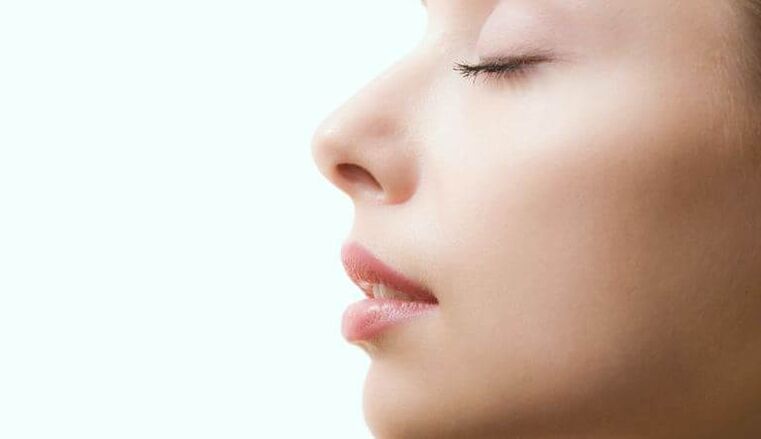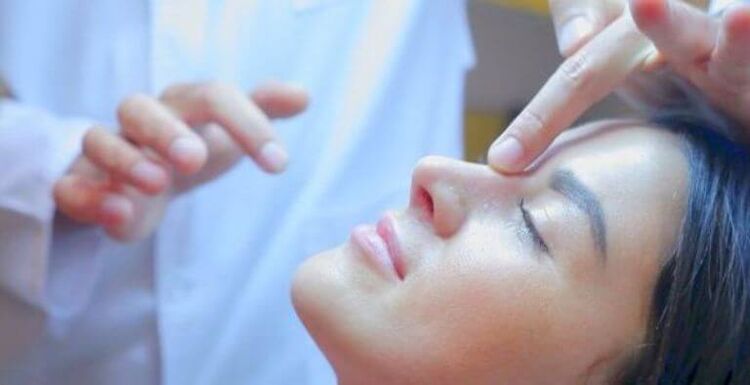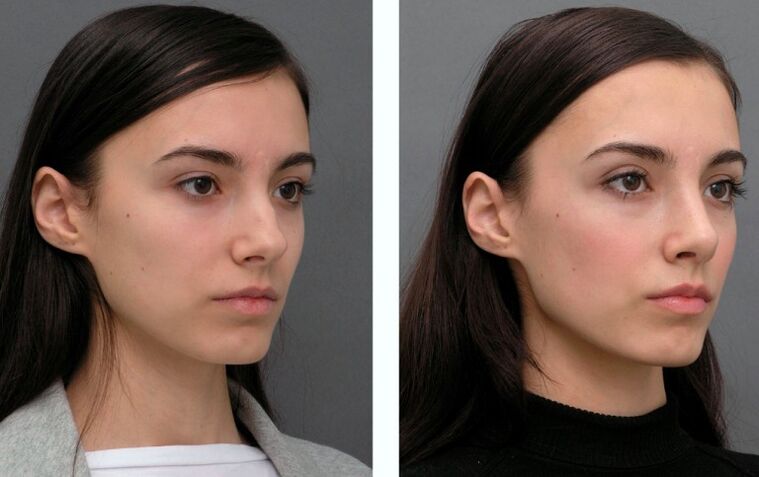Non-surgical rhinoplasty is a relatively new word in medicine, and few people know what it is.If many have already heard about classic surgical interventions, in this case a number of questions arise.If you have complexes due to defects associated with the olfactory organ, and an ugly peak, hump or depression interferes with your life, you should definitely find out what non-surgical rhinoplasty is.

Non-surgical rhinoplasty and its secrets
Non-surgical rhinoplasty is a way to correct the shape of the nose without surgery.The essence of the method is to introduce special fillers or threads into this area, which slightly correct the shape and give symmetry to this part of the face.Ideal for patients who do not have problems with breathing, nasal septum or nasal bone deformity.If there are minor defects in the shape of the nose, the use of fillers is an ideal solution as it helps correct these problems.It should also be noted that the term “non-surgical rhinoplasty” is somewhat incorrect and contradictory.“Rhinoplasty” is a surgical procedure on the nose, and the definition of “non-surgical” to use in this context is not entirely logical.
However, experts agreed to call the correction procedure “filler” in order to convey the essence of the method to patients who have little information about ways to correct the shape of the nose.This procedure cannot be considered a complete alternative to surgery.The aim is to combat certain defects that cannot be corrected by surgery.And vice versa, it cannot solve the problems that surgery eliminates.This technique is often used when the patient is dissatisfied with the results of surgical rhinoplasty and requires adjustment of the resulting nose shape.Before agreeing to the procedure, we recommend that you study the before and after photos to get a rough idea of the possible results.The nose cannot be reduced in size without surgery.By the way, nasal cartilage tends to increase with age, so some patients may report that their nose gets larger as they age.

5 clear differences between non-surgical rhinoplasty
This procedure has a number of differences from surgery, including:
- Lack of complex surgical interventions, long and painful rehabilitation period;
- speed of the procedure;
- reasonable costs;
- short-term effect (lasting up to a year);
- Inability to correct respiratory and other serious problems.
In other words, it is an almost simple procedure that guarantees a mild effect and is aimed at solving minor problems with the shape of the nose.For example, it can be used to improve the tip of the nose, eliminate a defect or balance relief.This technique can be used whenever results diminish.The most important requirement is the patient's satisfaction with the result achieved.When clients come in whose nose has been filled with fillers in the past, I use hyaluronidase to dissolve the remaining filler in the nose before further injections are performed.Essentially, we're starting over with a new chapter.Otherwise, there will be fillers in the nose that are in varying stages of dissolution, resulting in an uneven nose over time.
Non-surgical rhinoplasty results
With non-surgical rhinoplasty you can achieve the following results:
- achieving shape symmetry;
- Elimination of minor defects in the form of pits or tubercles under the skin;
- Correction of minor curvatures;
- lifting the tip of the nose;
- Adds a subtle touch to the nostrils.
As you can see from this list, non-surgical rhinoplasty is more of a corrective rhinoplasty than a correction of serious problems.Before signing up for this technique, the patient should consult a doctor, get recommendations and get a rough idea of the results in order to avoid disappointment from the procedure.What you should not expect from non-surgical rhinoplasty is radical changes in the shape of the nose and solutions to problems with respiratory function.The technology is not aimed at combating these problems.

What methods is used to carry out the procedure?
What methods are there and how does the process work?Conventionally, non-surgical rhinoplasty can be divided into the following types:
- fillers. This technique uses fillers based on hyaluronic acid.They fill in small irregularities, smooth the surface of the skin and ensure a symmetrical nose.Preparations based on hyaluronic acid and others are often used here.These products are typically classified as biodegradable, meaning they break down over time.There are also permanent fillers based on silicone or other biopolymers, but modern experts advise against using such fillers as they can cause tissue fibrosis.
- Topics. Aptos threads have been used for facelifts for approximately 20 years;They allow you to not only tighten and correct the contours of the cheekbones and facial contours, but also change the shape of the nose.The best option for those who want to raise the tip of the nose or smooth small wrinkles on the bridge of the nose, thereby visually improving the contour.Threads can also be biodegradable or permanent.
- Hormonal medications. They are also injected under the skin.They allow you to eliminate minor defects and visually make your nose thinner.The drugs are not intended to correct bone tissue.They resolve deficiencies.It is important that the exact dosage is adhered to.
- Rails. This name was given to a device made of plastic or plaster.Its use is intended to correct the contour of the olfactory organ.This device applies pressure to the cartilage tissue, correcting imperfections.With its help, you can raise the nose, narrow the wings and smooth out the curvature.However, you must understand that this method does not lead to colossal changes, but only copes with minor corrections.

The method of non-surgical rhinoplasty is chosen individually.In any case, the beautician must consult the patient and explain why the chosen method should be used.
Indications and contraindications for
The procedure should be carried out if there are certain defects.
Notes:
- the tip of the nose droops;
- Minor irregularities are observed.
- there is asymmetry;
- the upper bridge of the nose is flat;
- loose skin in this area.
Facial fillers can be used to improve the symmetry of the nose.However, to reduce the size of the nostrils or overall shape, surgery is required.
Dermatologist Jason Emer
In certain cases the procedure is contraindicated.
Contraindications:
- during pregnancy and breastfeeding;
- acute inflammatory processes;
- infectious diseases;
- herpes in the acute stage;
- diabetes mellitus;
- Presence of allergies to active ingredients and medications.

The procedure can be carried out once you reach adulthood and then at any age.
Rehabilitation phase
There is no rehabilitation phase as such.A few hours after the procedure, redness and swelling of the skin in the nasal area may be observed, but these problems completely disappear within 24 hours.A thread lift can cause bruising that will disappear completely within a week.In addition, a special splint is placed on the patient's nose, which secures the result and protects against injuries.After the injection, fillers can come loose and threads inserted under the skin of the nose can break.The likelihood of these side effects occurring is extremely low.However, if any are detected, it is urgent to see a specialist to quickly resolve the problem.
Bruising and swelling may occur after the procedure.It will take about 2 weeks for them to completely disappear.If you still experience these symptoms after this time, you should see your doctor.
Cosmetic dermatologist Paul Flashner
Benefits of Non-Surgical Rhinoplasty
What are the advantages and disadvantages of this rhinoplasty?The main advantages of this technique include:
- Painlessness;
- short period of time or complete absence of a rehabilitation period;
- rapid achievement of results;
- Reversibility.
Questions may arise about reversibility, because if the process has to be repeated again at a stable frequency, can this be considered a benefit?In a sense, yes, because with classic rhinoplasty it is simply impossible to restore the previous result;You may encounter an unsuccessful result.And what to do if it turns out that the patient is dissatisfied with the new nose shape?Corrective plastic surgery can correct the situation to some extent, but it will not be possible to completely reverse the result.And non-surgical rhinoplasty allows you to return to your previous shape at any time and without any changes.The duration of the result depends on the filler (preparations with hyaluronic acid) used.Re-intervention is usually required after 9-12 months.
Expert opinion

I cannot describe the procedure as completely safe.In my practice, it was common for patients to come in for a similar method and have severe skin ischemia.If the filler is inserted incorrectly, deformation of the cartilage may occur;This is a direct indication for subsequent corrective surgery.Therefore, you should choose a specialist carefully.Based on the information above, you can easily come to the conclusion that non-surgical rhinoplasty is not suitable for everyone.When it comes to minor defects that can be remedied with filler and slight shape adjustments, then this approach makes sense.In other cases, when it comes to correcting serious defects such as a septal deformity or a crooked bone, it is necessary to perform a classic operation and eliminate the problem using a painful but complete method.In the case of minor defects, non-surgical rhinoplasty can correct the situation and give symmetry to the face.However, it is worth remembering the risks of side effects.






















